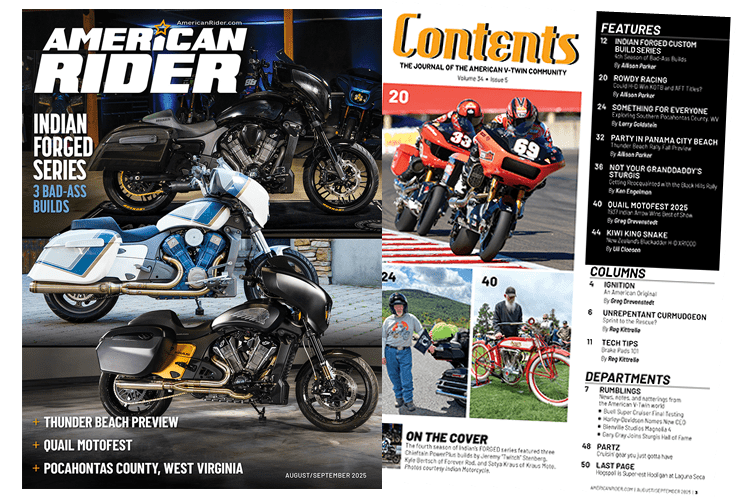Last time around we talked briefly about a few of the neat (and unsung) supporting players in the total redesign of the 2018 Softails. This time… let’s dig a little deeper into the engine and chassis combo that’s got everyone rethinking Harley’s cruiser image. Or should! After all… dynamically… about the only thing these new machines have in common with what came before is the name! Here are some of the reasons why.

Most pictures of the Softail 3.0 frame show the thing wrapped around the M-8 engine… for good reason. This frame is only half of the “chassis”… not much more good without the engine than the engine would be without the frame. (Can you say, “Symbiotic relationship?”) The objective is to use the engine to create an inflexible triangle… more or less in two different planes. Looking from the side as in this pic, it prevents the backbone of the frame from bending when traversing bumps and dips. Looked at head on… the triangle effect helps keep the steering head and the rear axle strictly perpendicular (not always the case with past Harley frames). The position of the shock helps feed loads from the rear wheel straight up the stiff spine of the frame to the steering head… and reduces any tendency to bend or twist the downtubes. Flex, lateral stiffness and torsional stiffness are all well controlled as a result. That’s why they handle! Also… H-D’s factory specs cite a 34-percent improvement over the Twinkie Softail and a whopping 94 percent over the Dyna! This has as much to do with the respective swingarm designs as the frame itself, any Softail triangular arm being stiffer than any twin shock parallel arm!

To clear up any confusion… Softails indeed have three different rake-and-trail setups, fork- and wheel-related, by model. But not in the frame. The triple trees are where the 28-, 30- and 34-degree differences lie… each of these being raked to suit the intended purpose. Treating the frame as a constant and doing steering variations via the trees… is more important than you might think. It contributes a lot to the individual handling characteristics of each model.. and how “individual” each Softail is! It’s startling… climbing off one model and onto another back-to-back! The factory’s deft use of all the variables… handlebars, forks, trees, wheels and even the lengths and spring rates of the nitrogen-filled rear shocks… gives each version of 2018 Softail a unique feel and feedback to the rider. They might all use the same chassis, but they sure don’t all feel the same to the rider! Clever… that!

If it’s what’s up front that counts… what’s inside what’s up front matters even more. Case in point: with a stiffer, more predictable chassis, suspension spring rates need to be more precise and damping rates calibrated to cover a wider range of road variables… in other words… a smoother, safer, more inspiring ride at almost any velocity over a wide range of road surfaces. Showa’s “dual bending valve” technology, as applied to Softail progressive spring rate forks, is a prime example of the huge improvement in damping a couple of little flexible discs can make! No one used to traditional H-D damper rod forks can fail to notice how much better these DBV forks are! The Motor Company likes to say DBV “delivers the performance of racing-style cartridge forks with linear damping characteristics.” Sure enough, at speed over the regular irregularities they work flawlessly. But there’s this one odd little thing. The DBV forks’ only glitch is a slight case of “jolting” over small, sharp asphalt cracks and frost heaves. On the other hand… the only new Softail with double-disc brakes is also the only one with upside-down/inverted (cartridge) forks… and the Street Bob doesn’t do it at all.

You might already be wondering about this; the 3.0 Softails don’t get a 117″ engine and both the 107″ and 114″ are oil cooled only… no “twin-cooled” models at all. By contrast the Touring lines offer no 114″ models this year…yet there are twin-cooled 107″ bikes and a 117″ CVO engine that isn’t! Well… first off… the Milwaukee-Eight ain’t no Twin Cam! Fact is, sort of “off the record,” the M-8 doesn’t need water cooling around the heads because, by design, the four-valvers run way cooler… since the volumetric efficiency is higher. There’s even reliable evidence that a Stage Four Screamin’ Eagle 117″ engine kit applied to a Fat Bob 114″ does nothing but make it scary freakin’ fast… without any thermal or reliability issues. The evidence is clear. There’s a ton of untapped potential in the M-8. Just thought you’d like to know.

Besides the phased, gear-driven twin balancers and the subtle fact that the Softail version of the M-8 engine has the transmission tilted in the chassis (just a few degrees, for greater lean angles and ground clearance) there’s a difference in primary drives as well. Since some versions of Softail come with (Ahem!) wide tires, yet still lean and handle really well… this should come as no surprise. What might is the inner primary widths. Even the primary covers are different, both in shape and dimension… to the point where the gaskets aren’t even interchangeable with Touring models. Bottom line… even though there are definite similarities in the two “siblings”… as of 2018 the M-8 engine effectively comes in two distinct layouts… tailored for two distinctive platforms.

Lastly (for the time being) you shouldn’t put too much faith in brochure BS regarding published lean angles… especially where the new Softails are concerned. The specs come from an SAE-mandated procedure that in no way reflects real-world capabilities. For one thing these specs dictate the suspension be loaded (front and rear) to 75 percent of capacity before the bike is leaned over. There is no situation short of being dropped off a building where that actually occurs on any motorcycle! You might get close with one end or the other, under extreme circumstances, but both at the same time? Un-huh! What it all amounts to is “real” lean angles are greater than you think and the new Softail lets you effortlessly explore and exploit that good news to a higher degree (get it?) than ever!



















[…] Read Classy Chassis (Part II) here. […]
This is an EXCELLENT brief article. We need a more focussed account of varying the rake through the triple clamps as opposed to the steering neck itself. Is there TRULY no technical sacrifice being made by doing this? If the bike is level and suspension is not altered as to length and the nominal rake of the frame as manufactured is 30 degrees altering the fork tube angles with the triple clamps to 28 degrees or 34 degrees is not a technical sacrifice? Please do not consider Trail here for the moment. Is there any limit assuming the tire stays free to turn. Could we use custom clamps to go to 24 degrees? Please stay away from extremes as I am trying to visualize this relationship between differing steering tube and fork tube angles.
Anyone? 🙂
The biggest fix I see here is that the swing arm pivot location has been moved up to where it should have been originally.
Never cared for the original location of the swing arm pivot, forward thrust would unload the rear tire because the axle was higher than the pivot.